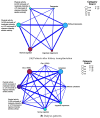Sedentary Lifestyle Is a Modifiable Risk Factor for Cognitive Impairment in Patients on Dialysis and after Kidney Transplantation
- PMID: 39458033
- PMCID: PMC11508775
- DOI: 10.3390/jcm13206083
Sedentary Lifestyle Is a Modifiable Risk Factor for Cognitive Impairment in Patients on Dialysis and after Kidney Transplantation
Abstract
Background: Chronic kidney disease (CKD) is a risk factor for cognitive impairment (CI), and this risk is the highest in patients with end-stage kidney disease (ESKD). As a multifactorial disease, CI may be influenced by several potentially modifiable lifestyle and behavioral factors that may reduce or increase the risk of dementia. The aim of this study was to evaluate the associations between the known modifiable risk factors for dementia and the risk of CI in patients with ESKD treated with renal replacement therapy. The Charlson Comorbidity Index and the risk of CI in patients with ESKD were also assessed. Methods: In this cross-sectional study, 225 consecutive patients with ESKD treated with different modalities of renal replacement therapy were assessed for cognitive decline using the Addenbrooke's Cognitive Examination (ACE III) test. Information was also collected on modifiable risk factors for dementia, medical history and demographics. Results: This study included 117 patients after kidney transplantation (KT) and 108 patients with ESKD undergoing peritoneal dialysis and hemodialysis. The prevalence of modifiable risk factors for dementia differed between the groups; KT patients were more likely to be physically active, residing in cities with populations of less than 500,000 inhabitants, and were less likely to suffer from depression. Furthermore, the KT group had a lower Charlson Comorbidity Index score, indicating less severe comorbidities, and a lower risk of CI (3.6 ± 1.67 vs. 5.43 ± 2.37; p = 0.001). In both the KT and dialysis groups, patients with CI were more likely to have a sedentary lifestyle (45% vs. 9%, p = 0.001 and 88% vs. 48%, p = 0.001, respectively), whereas lower educational attainment and depression had a significant negative impact on ACE III test results, but only in KT patients. Finally, cognitive function in dialysis patients was negatively affected by social isolation and living in urban areas. Conclusions: Modifiable risk factors for dementia, particularly a sedentary lifestyle, are associated with a higher risk of CI in patients treated with different renal replacement therapy modalities. As CI is an irreversible condition, it is important to identify lifestyle-related factors that may lead to dementia in order to improve or maintain cognitive function in patients with ESKD.
Keywords: cognitive impairment; dementia; educational attainment; end-stage kidney disease; modifiable risk factors; renal replacement therapy; sedentary lifestyle.
Conflict of interest statement
The authors declare no conflict of interest.
Figures

Similar articles
-
Cognitive Impairment and Anxiety Are Prevalent in Kidney Transplant Recipients.Kidney Blood Press Res. 2023;48(1):587-595. doi: 10.1159/000533755. Epub 2023 Aug 24. Kidney Blood Press Res. 2023. PMID: 37619550 Free PMC article.
-
Cognitive impairment in patients awaiting kidney and liver transplantation-A clinically relevant problem?Brain Behav. 2024 Aug;14(8):e3647. doi: 10.1002/brb3.3647. Brain Behav. 2024. PMID: 39135287 Free PMC article.
-
Comparison of health literacy profile of patients with end-stage kidney disease on dialysis versus non-dialysis chronic kidney disease and the influencing factors: a cross-sectional study.BMJ Open. 2020 Oct 29;10(10):e041404. doi: 10.1136/bmjopen-2020-041404. BMJ Open. 2020. PMID: 33122326 Free PMC article.
-
Renal Replacement Therapy For Elderly Patients with ESKD Through Shared Decision-Making.Electrolyte Blood Press. 2023 Jun;21(1):1-7. doi: 10.5049/EBP.2023.21.1.1. Epub 2023 Jun 27. Electrolyte Blood Press. 2023. PMID: 37434803 Free PMC article. Review.
-
Prevalence and incidence of chronic kidney disease stage G5 in Japan.Clin Exp Nephrol. 2015 Feb;19(1):54-64. doi: 10.1007/s10157-014-0978-x. Epub 2014 May 13. Clin Exp Nephrol. 2015. PMID: 24821288 Review.
References
-
- Pépin M., Klimkowicz-Mrowiec A., Godefroy O., Delgado P., Carriazo S., Ferreira A.C., Golenia A., Malyszko J., Grodzicki T., Giannakou K., et al. Cognitive disorders in patients with chronic kidney disease: Approaches to prevention and treatment. Eur. J. Neurol. 2023;30:2899–2911. doi: 10.1111/ene.15928. - DOI - PubMed
LinkOut - more resources
Full Text Sources
Research Materials
Miscellaneous

